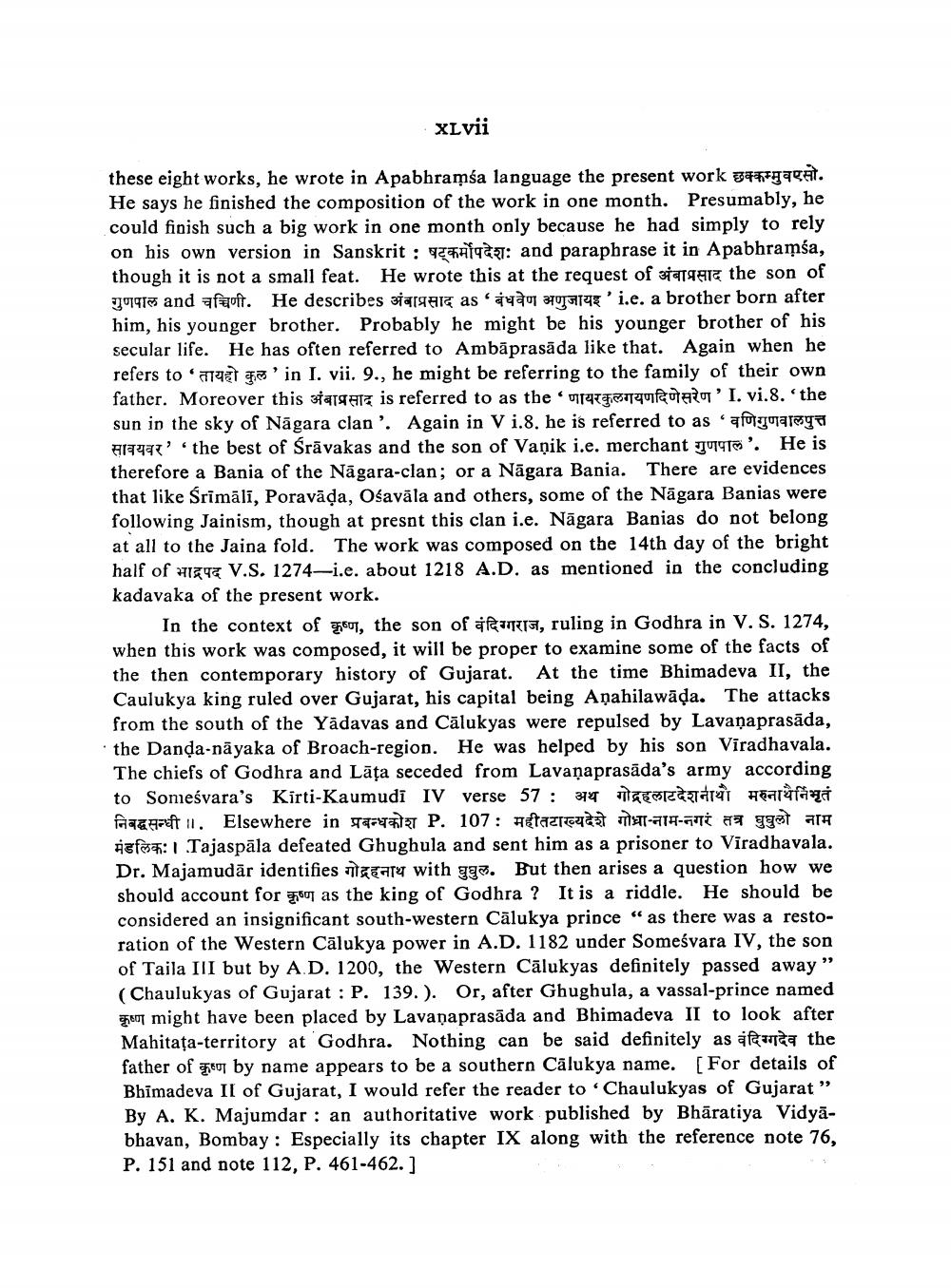________________
XLvii
these eight works, he wrote in Apabhramśa language the present work #7777CA. He says he finished the composition of the work in one month. Presumably, he could finish such a big work in one month only because he had simply to rely on his own version in Sanskrit : 9hat: and paraphrase it in Apabhramsa, though it is not a small feat. He wrote this at the request of 31 Tas the son of गुणपाल and चचिणी. He describes अंबाप्रसाद as 'बंधवेण अणुजायइ' i.e.a brother born after him, his younger brother. Probably he might be his younger brother of his secular life. He has often referred to Ambāprasāda like that. Again when he refers to 'alget 'in I. vii. 9., he might be referring to the family of their own father. Moreover this stage is referred to as the officiu ' I. vi.8. 'the sun in the sky of Nāgara clan'. Again in V i.8. he is referred to as 'afuyugtago #1997' 'the best of Srāvakas and the son of Vanik i.e. merchant 7079 '. He is therefore a Bania of the Nāgara-clan; or a Nāgara Bania. There are evidences that like Srimālī, Poravāda, Ośavāla and others, some of the Nāgara Banias were following Jainism, though at presnt this clan i.e. Nāgara Banias do not belong at all to the Jaina fold. The work was composed on the 14th day of the bright half of H34 V.S. 1274-i.e. about 1218 A.D. as mentioned in the concluding kadavaka of the present work.
In the context of #607, the son of a ma, ruling in Godhra in V. S. 1274, when this work was composed, it will be proper to examine some of the facts of the then contemporary history of Gujarat. At the time Bhimadeva II, the Caulukya king ruled over Gujarat, his capital being Aộahilawāda. The attacks from the south of the Yadavas and Cālukyas were repulsed by Lavaņaprasāda, the Danda-nāyaka of Broach-region. He was helped by his son Viradhavala. The chiefs of Godhra and Lāța seceded from Lavaņaprasāda's army according to Someśvara's Kirti-Kaumudi IV verse 57 : 374 za tarat Hargfalt fragraf . Elsewhere in 42 P. 107: Hetaste 1-214--07€ 17 ggat ata Hef: 1 Tajaspāla defeated Ghughula and sent him as a prisoner to Viradhavala. Dr. Majamudār identifies nicate with gga. But then arises a question how we should account for too as the king of Godhra ? It is a riddle. He should be considered an insignificant south-western Cālukya prince “as there was a restoration of the Western Cālukya power in A.D. 1182 under Someśvara IV, the son of Taila III but by A.D. 1200, the Western Cālukyas definitely passed away ” (Chaulukyas of Gujarat : P. 139.). Or, after Ghughula, a vassal-prince named hou might have been placed by Lavanaprasāda and Bhimadeva II to look after Mahitaţa-territory at Godhra. Nothing can be said definitely as a ga the father of go by name appears to be a southern Cālukya name. [For details of Bhimadeva II of Gujarat, I would refer the reader to 'Chaulukyas of Gujarat" By A. K. Majumdar : an authoritative work published by Bhāratiya Vidyābhavan, Bombay : Especially its chapter IX along with the reference note 76, P. 151 and note 112, P. 461-462.]




